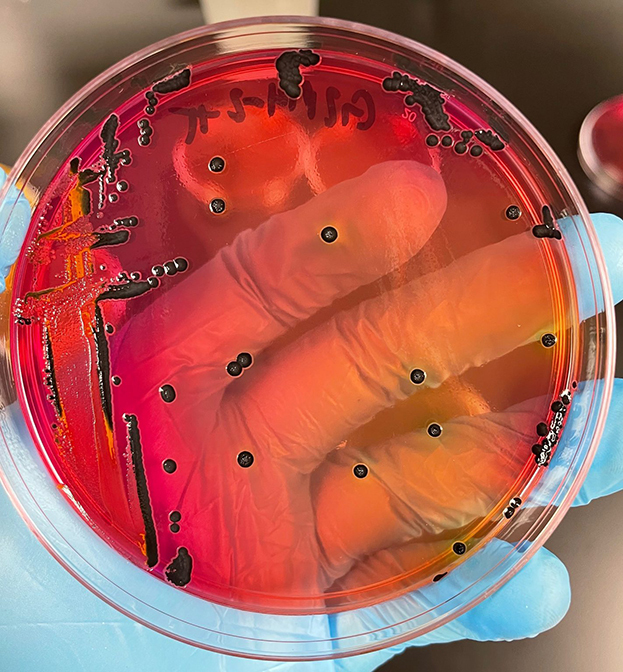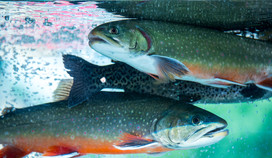|
Having trouble viewing this email? View it as a Web page.

|
|
|
Editor: Kelly Sprute July 7, 2021
Making a Difference

Salmonella colonies growing on red indicator plates, image courtesy of the University of Georgia.
Harmful Bacteria Hiding in Livestock; Traditional Methods Aren’t Finding Them
Growing resistance to science’s go-to antibiotics is one of the biggest threats the world faces. As common bacteria like strep and salmonella become resistant to medications, what used to be easily treatable infections can now pose difficult medical challenges. New research from the University of Georgia (UGA) shows that there may be more antimicrobial-resistant salmonella in our food animals than scientists previously thought.
Using technology; she developed, UGA researcher Nikki Shariat and Amy Siceloff, a first-year doctoral student in UGA’s Department of Microbiology, found that traditional culturing methods used to test livestock for problematic bacteria often miss drug-resistant strains of salmonella. This finding has implications for treating sick food animals and the people who get infected by eating contaminated meat.
The study, published in Antimicrobial Agents and Chemotherapy, showed that 60 percent of cattle fecal samples contained multiple strains of salmonella that traditional testing methods missed. More alarmingly, Shariat found that about one out of every 10 samples tested positive for a drug-resistant strain of salmonella called Salmonella Reading which can cause severe illness in people. This study was funded by USDA’s National Institute of Food and Agriculture. For more information, read this UGA newswire article.
|
|

As part of our continuous quality improvement program, I’m excited to announce two new developments at NIFA this week.
First, we have added a new National Science Liaison to our team, Michael Mathews. Michael comes to NIFA with a wealth of knowledge and experience at USDA and will focus on improving our service to minority-serving institutions. Michael was an 1890s Scholar and graduated from Prairie View A&M in Texas.
We also have some products ready to make it easier to for you to navigate information on NIFA’s website. The NIFA Website Improvement team has published a new Capacity Grants flowchart that details each step of the capacity grant process, similar to the Competitive Grants process flowchart published early in a Project CAFÉ initiative.
Additionally, the Re-Engineering Requests for Applications (RFA) team is in the final stages of defining its short-, mid- and long-term improvement recommendations for NIFA’s RFAs. After extensive analysis of the broader RFA landscape across Federal granting agencies, the team is excited about the resulting set of RFA improvement opportunities. These improvements encompass document structure and layout optimization, increased focus on user-friendly language and improved linkages to application support resources.
Project CAFÉ teams recently began the second phase of implementing eight prioritized long-term initiatives. To reflect this new phase, the Project CAFÉ Dashboard has been revised to highlight the focus of CAFÉ initiatives from June 2021 through November 2021 as well as to document the accomplishments from the implementation phase that ended June 1, 2021.
Please continue to visit the Project CAFÉ Dashboard and follow the progress on these initiatives as they move forward into this next phase.
Dr. Carrie Castille
Director, National Institute of Food and Agriculture
|

NIFA Invests $14M in Animal Health and Disease Research
The USDA’s National Institute of Food and Agriculture (NIFA) announced today an investment of $14 million in research to protect agricultural animals from disease. The grants are part of NIFA’s Agriculture and Food Research Initiative’s Diseases of Agricultural Animals Program.
“Animal health is critically important to farmers and ranchers,” said NIFA Director Dr. Carrie Castille. “This research will help better understand, diagnose, control and prevent diseases in agricultural animals and aquaculture.” For more information, read the NIFA announcement.
Veterinarian examining a horse, courtesy of Getty Images.
|

NIFA Invests $6.2M to Prepare More Teachers in Food and Ag Science
NIFA announced today an investment of $6.2 million for 21 Professional Development for Agricultural Literacy grants, part of our FY2020 competition that will increase the number of K-14 teachers and educational professionals trained in the food and agricultural sciencesthat will increase the number of K-14 teachers and educational professionals trained in the food and agricultural sciences. These grants are part of NIFA’s Agriculture and Food Research Initiative.
“As we work to build the talent pipeline for agricultural science, technology and business, we have to reach young people while they are in high school,” said NIFA Director Dr. Carrie Castille. “With this support from NIFA, teachers can develop skills necessary for integrating food and agricultural science into their classes; explore food and agricultural science career paths; and forge mentorships with agricultural professionals, business leaders and university faculty that will help guide the next generation of agricultural scientists and leaders.” For more information, read the NIFA announcement.
Teaching agriculture to school children, courtesy of Getty Images.
|

Dusk in America’s heartland, courtesy of Adobe Stock
USDA Seeks to Strengthen the Nation's Food System
One USDA priority is to transform the nation's food system, to make it more resilient and able to withstand any future crisis. USDA’s Stephanie Ho talks with Agriculture Secretary Tom Vilsack on how the USDA is creating a more robust food system. For more information, listen to the USDA broadcast.

NIFA Career Opportunities
We are hiring! Remember to check out NIFA's Career Opportunities webpage, where there is a direct link to all open positions. You can also explore NIFA jobs at the USAjobs.gov website. Current openings in Kansas City, Missouri:
Equal Opportunity Specialist (GS-13)
Closing Date: 07/08/2021
Biological Science Specialist (National Program Leader) (GS 13-14)
Closing Date: 07/09/2021
Supervisory Biological Science Specialist (Division Director) (GS-15)
Closing Date: 07/15/2021
Staff Accountant (GS 9-12)
Closing Date: 07/20/2021
Staff Accountant (GS 9-12)
Closing Date: 07/20/2021
|

New Research on Aquaculture Feed will Test Alternative Ingredients to Minimize Water Pollution
Researchers from University of California - Santa Cruz’s ecological aquaculture lab won a three-year, $1 million grant from USDA-NIFA’s Agriculture and Food Research Initiative. This funding will support collaborative research to develop, test, and evaluate new low-polluting fish feed formulas for farm-raised rainbow trout. Associate Research Professor of Environmental Studies Pallab Sarker will lead this work alongside Environmental Studies Professor Anne Kapuscinski and Luke Gardner, a California Sea Grant extension specialist affiliated with UC San Diego. The team will use a marine microalga as an ingredient in their fish feed, and the resulting experimental formulas will be field-tested at working trout farms in California. The goal is to create an environmentally sustainable and economically viable feed option that maximizes fish growth while limiting the potential for water pollution during the fish farming process. For more information, read this UC Santa Cruz Newscenter article.
Underwater image of rainbow trout, courtesy of Adobe Stock.
|

USDA Grant to Advance Research on Crop, Livestock Traits
The University of Nebraska—Lincoln (UNL) and three partner institutions have received nearly $1 million to expand the Agricultural Genome to Phenome Initiative. The $960,000 award from USDA's National Institute for Food and Agriculture supports phase two of the three-year effort led by Iowa State University. The program won initial NIFA funding of $960,000 last September. The initiative aims to increase understanding of how genetic code affects physical and behavioral traits, or phenotypes, in crops and livestock. Additionally, the initiative aims to standardize and streamline how phenomic information is collected and shared by agronomists, researchers, and others. Ultimately, the project could lead to the speedier development of disease, weather, and pest-resistant crops, and livestock. For more information, read this Nebraska Today article.
Corn seedlings with sunlight, courtesy of Adobe Stock.
|

|
|
|
NIFA’s mission is to invest in and advance agricultural research, education, and extension that solve societal challenges. NIFA’s investments in transformative science directly support the long-term prosperity and global preeminence of U.S. agriculture. Keep informed about NIFA, USDA, our land-grant and non-land-grant university partners, and stakeholders with the NIFA Update. Read past issues online, sign up for email updates or follow us on Twitter @USDA_NIFA, #NIFAImpacts or LinkedIn @usda-nifa.
If you wish to submit a news item or information, send an email to NIFAUpdate.
USDA is an equal opportunity lender, provider, and employer.
|
|
|
|